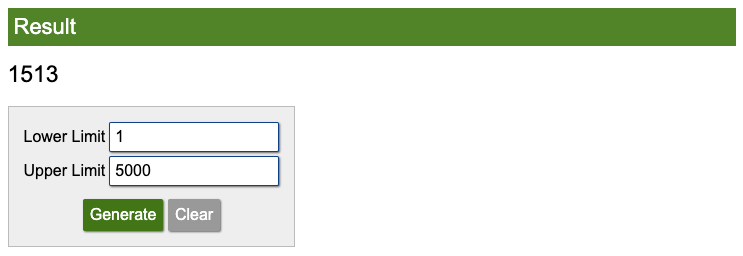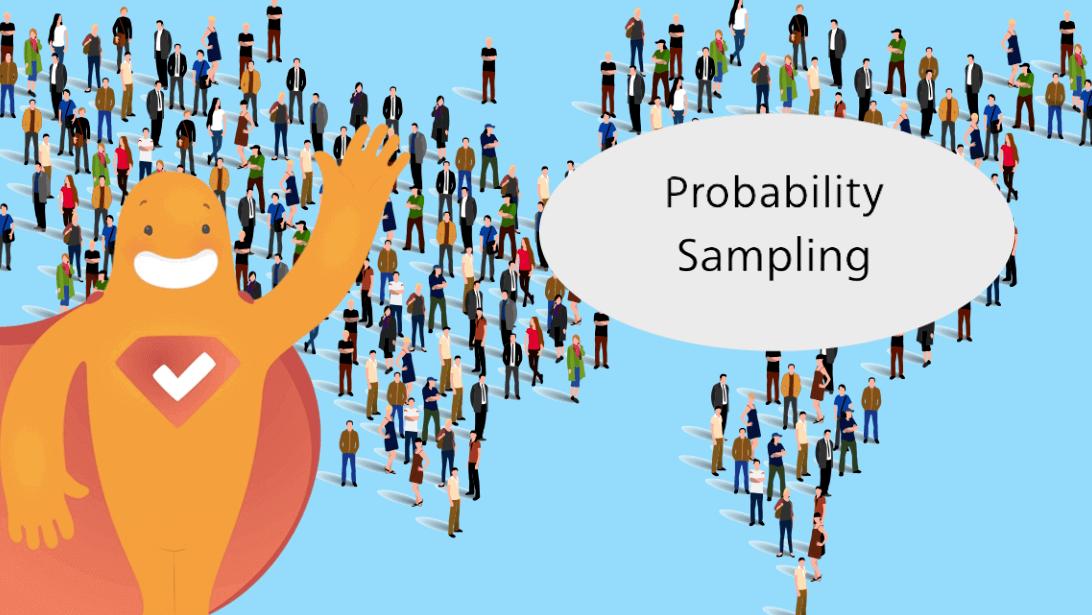Data that skews one way or another can lead to bad decisions and incorrect conclusions. Often, data is unreliable because researchers who are unable to survey every member of a particular population select a subset of that population that doesn’t represent the group as a whole. However, by employing probability sampling, researchers have the best chance of obtaining a representative sample. Here’s how it works, different methods of probability sampling, how it differs from non-probability sampling, and more.
Create your FREE Survey, Poll, or Questionnaire now!
Probability Sampling Definition
What does probability sampling mean? Probability sampling is one of many sampling methods. It aims to ensure that everyone in a population has an opportunity to be part of a sample. To achieve this, a subset of the population is selected at random. This is the opposite from non-probability sampling, in which the researcher has some amount of control over who is selected, meaning that not everyone will have a chance of being surveyed.
To better understand the difference between probability sampling vs non-probability sampling, consider a store owner with 5,000 customers. She decides to survey them about their shopping experience. Since surveying 5,000 people is too costly and time consuming, she decides to survey 10% of them.
With probability sampling, which involves giving everyone within the sample an equal chance of being selected, she uses a number generator (1 – 5,000) to select 500 customers at random from her customer database that correspond with the numbers generated.
With non-probability sampling (read more here), she doesn’t care that everyone has an equal chance of being chosen so long as she surveys 500 of them. So, she stands outside her store and surveys each customer that stops by until she reaches 500. She could also send an online survey to the first 500 customers in her database. In either situation, 4,500 people did not have the chance to be surveyed because selection was not random.
Probability Sampling Methods
How many types of probability sampling are there? Generally, a researcher will select one of four probability sampling techniques.
1. Simple Random Sampling
As implied by its name, simple random sampling is the easiest way of randomly sampling from a population. All the researcher needs to do is assign numbers to everyone in the sample and then randomly choose those numbers. To be sure the numbers are chosen at random, an automated process is typically employed. The numbers chosen, which represent members of the population, are then surveyed.
2. Systematic Sampling
Rather than just selecting numbers willy-nilly, systematic sampling draws a random sample from the target population by selecting units at regular intervals starting from a random point. This is known as choosing every “nth” (e.g. 5th, 10th, 12th, etc) individual. This fixed, periodic “nth” is known as the sampling interval.
To proceed with this probability sampling technique, the researcher will divide their population size by the desired sample size. The result is the interval. Then, the researcher will choose a starting point by selecting a number between 0 and the interval. The selection of the next units from other intervals depends upon the position of the unit selected in the first interval. Sound confusing? It’s easier than it may seem. Read more and see an example in our blog on Systematic Sampling.
3. Cluster Sampling
This sampling method is all about dividing the target population into groups or “clusters.” Next, a subsection of each group is randomly selected. Cluster sampling is typically employed when a researcher is studying a large and geographically spread out population that happens to share similarities (e.g. number of children, occupation, or college major).
Three types of cluster sampling exist:
- Single or one-stage cluster sampling which involves dividing the entire population into clusters, e.g. accountants within the United States.
- Double or two-stage cluster sampling, which goes a step further to narrow the scope. They could use simple random sampling or systematic sampling in this scenario, e.g. every “nth” accountant within the United States.
- Multistage cluster sampling which involves dividing the cluster into more clusters as a way to narrow down the sample size, e.g. every “nth” accountant within the United States who graduated from a top-tier university.
4. Stratified Random Sampling
Last but not least, stratified random sampling involves dividing a large population into smaller groups that typically don’t overlap but represent the entire population. Often, this means classifying groups by demographic factors such as gender, age, race, ethnicity, and so on.
The researcher splits subjects into mutually exclusive demographic groups and then uses simple random sampling to select members. These members need to be distinct so that each gets an equal opportunity to be chosen; for that reason, this method of sampling is sometimes referred to as “random quota sampling.”
Probability Sampling Randomization Methods
Randomization is very important in probability sampling. Here are the top three ways to ensure a sample is random.
Lottery Method
While it may not seem very scientific, the lottery sampling method is most definitely random. It involves simply writing names (or corresponding numbers) on a piece of paper and placing them into a hat, fishbowl, shoebox, or other holder of the researcher’s choice, and then selecting them at random. All participants have an equal chance of being selected and personal preference cannot be factored in. Of course, this method is really only feasible when the total population is small (e.g. students in a classroom, employees in a department, and so on).
Number Generator
When sample sizes are large, many researchers use computer-aided simple random sampling methods such as the random number generator available on Calculator.net. For example, a researcher has a population of 5,000 but can only afford to sample 100 of them. They simply adjust the limits and click “Generate” to reveal a random number (in the screenshot below, it’s 1513). They do this 100 times to determine the sample members.

Microsoft Excel RAND Function
Most researchers house their data in a Microsoft Excel spreadsheet, making randomization easy. Again, a researcher has a database of 5,000 and wants a sample of 100. By typing in the formula =RAND() and then pressing enter, Excel assigns a random number to each name on the list. Check out the video below for more on the RAND function.
Advantages of Probability Sampling
Probability sampling pros make it a great research method. For one, it generally offers results that are representative of the target population. Unlike forms of non-probability sampling (such as convenience sampling, in which researchers just select participants that are easily accessible to them), probability sampling is completely random. That means that every participant has an equal chance of being part of the selection.
Note: Though unlikely, it is possible for a random sample to result in skewed data. For example, if a researcher pulled 20 names from 100 out of a hat and all 25 happened to be men. To avoid this, the researcher could place 50 men’s names in one hat and 50 women’s names in another, and select 10 from each.
In addition, unlike non-probability sampling in which the potential for sampling bias is high (e.g. a researcher choosing people he or she is comfortable with or who fall into a certain demographic), this isn’t true of probability sampling. By choosing participants at random, a researcher’s personal views and opinions cannot influence the sample.
Probability Sampling with SurveyLegend Online Surveys
Online surveys are a great way to conduct probability sampling. They are convenient for respondents, who can complete them at the time and place of their choice, and cost-efficient for the researcher because of reduced interview costs and the ability to easily reach across geographical boundaries.
With SurveyLegend, our online surveys are easy to create and easy on the eyes – that’s because you can add pictures to surveys, boosting engagement, triggering respondent emotion and memory, and crossing language barriers. Below is an example of one of our photo surveys, designed to match the small business survey we highlighted at the start of this blog. You’ll note that multiple types of survey questions are used to engage participants, including a picture question, opinion scale, and a rating system.

Conclusion
Probability sampling is a great way for researchers to scientifically survey a small population or a smaller subset of a large population. When researchers use randomization to determine sample groups, there’s no room for researcher bias and sampling bias. This results in data that is typically very reliable. Whether you choose this type of sampling or another technique, SurveyLegend has you covered. We let you start for free, and have dozens of beautiful and responsive online survey templates from which to choose.
Do you use probability sampling when surveying? If so, what randomization technique do you use? Let us know in the comments!
Create your FREE Survey, Poll, or Questionnaire now!
Frequently Asked Questions (FAQs)
Probability sampling is a sampling technique that helps ensure everyone in a population has an opportunity to be sampled by employing random sampling methods.
Probability sampling uses randomization to ensure a high level of representation, whereas non-probability is not random, which could lead to unreliable data usually caused by researcher or sampling bias.
There are four main methods of probability sampling: simple random sampling, stratified random sampling, cluster sampling, and systematic sampling. Read more about them all (and much more) in the blog 8 Types of Survey Sampling + Pros & Cons, Errors & Bias, and More.
The three main randomization techniques are lottery methods (drawing names from a hat), using an online number generator tool, or using the RAND function in a Microsoft Excel spreadsheet.




